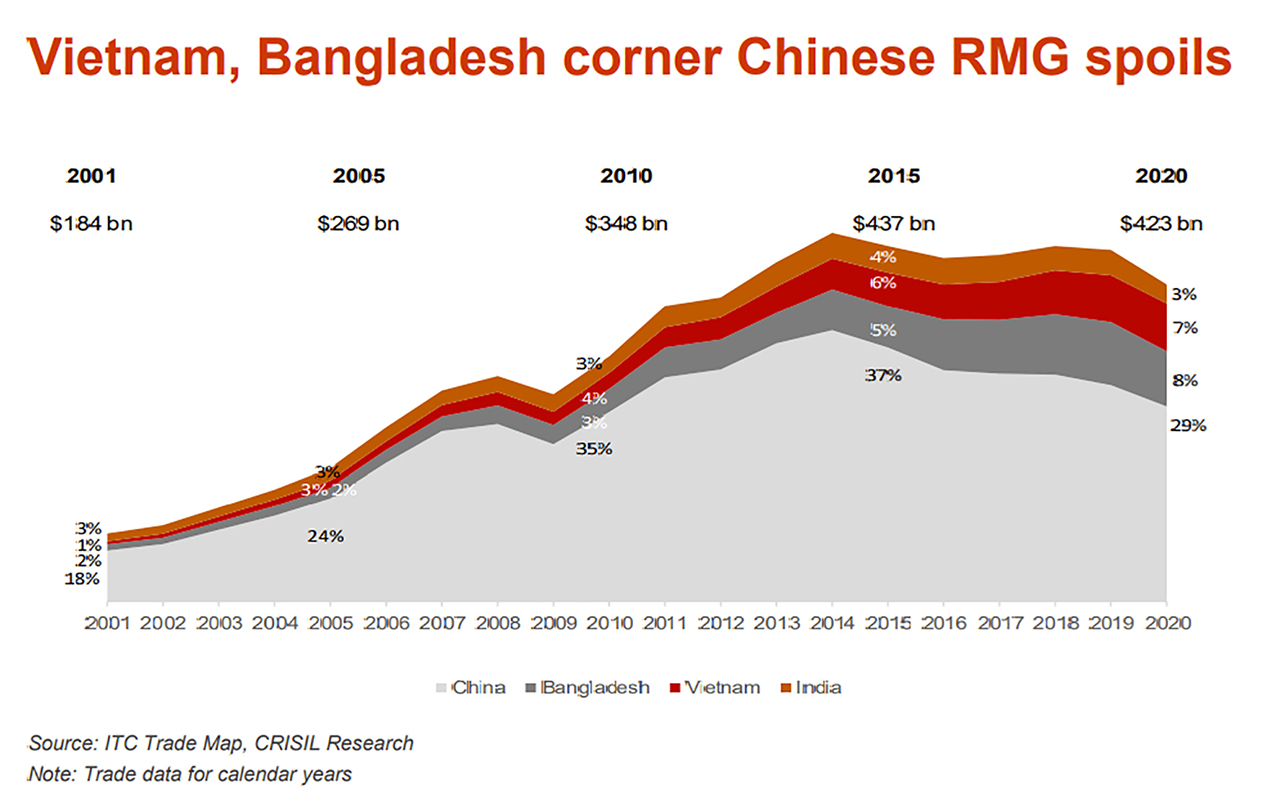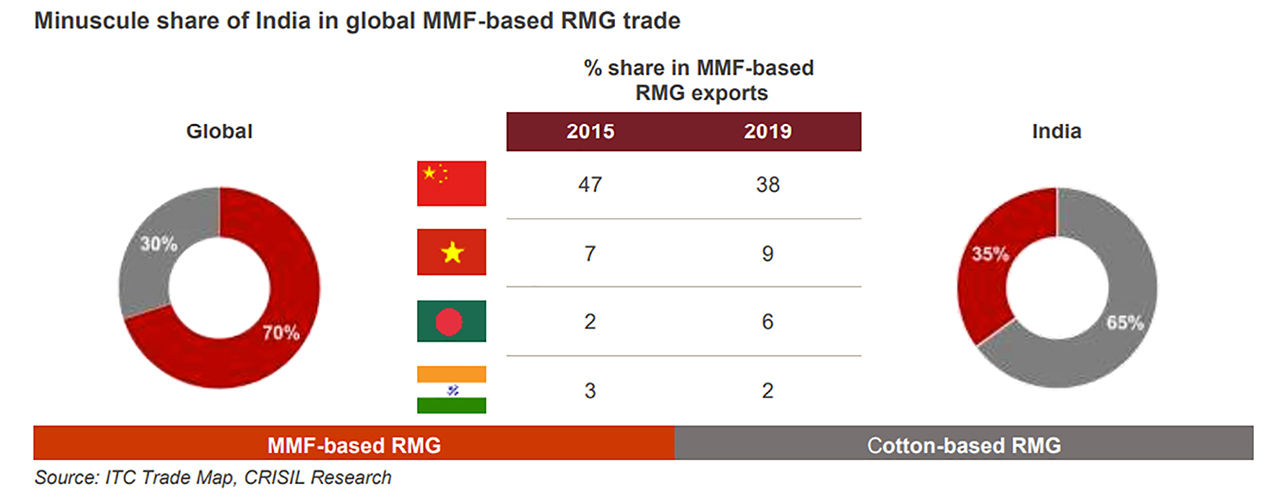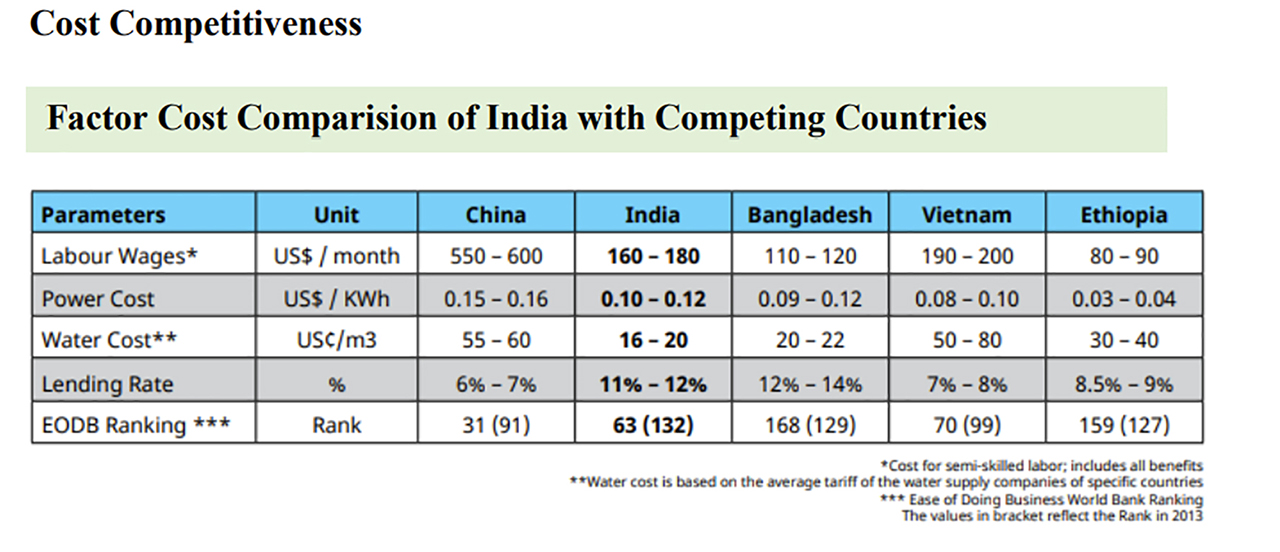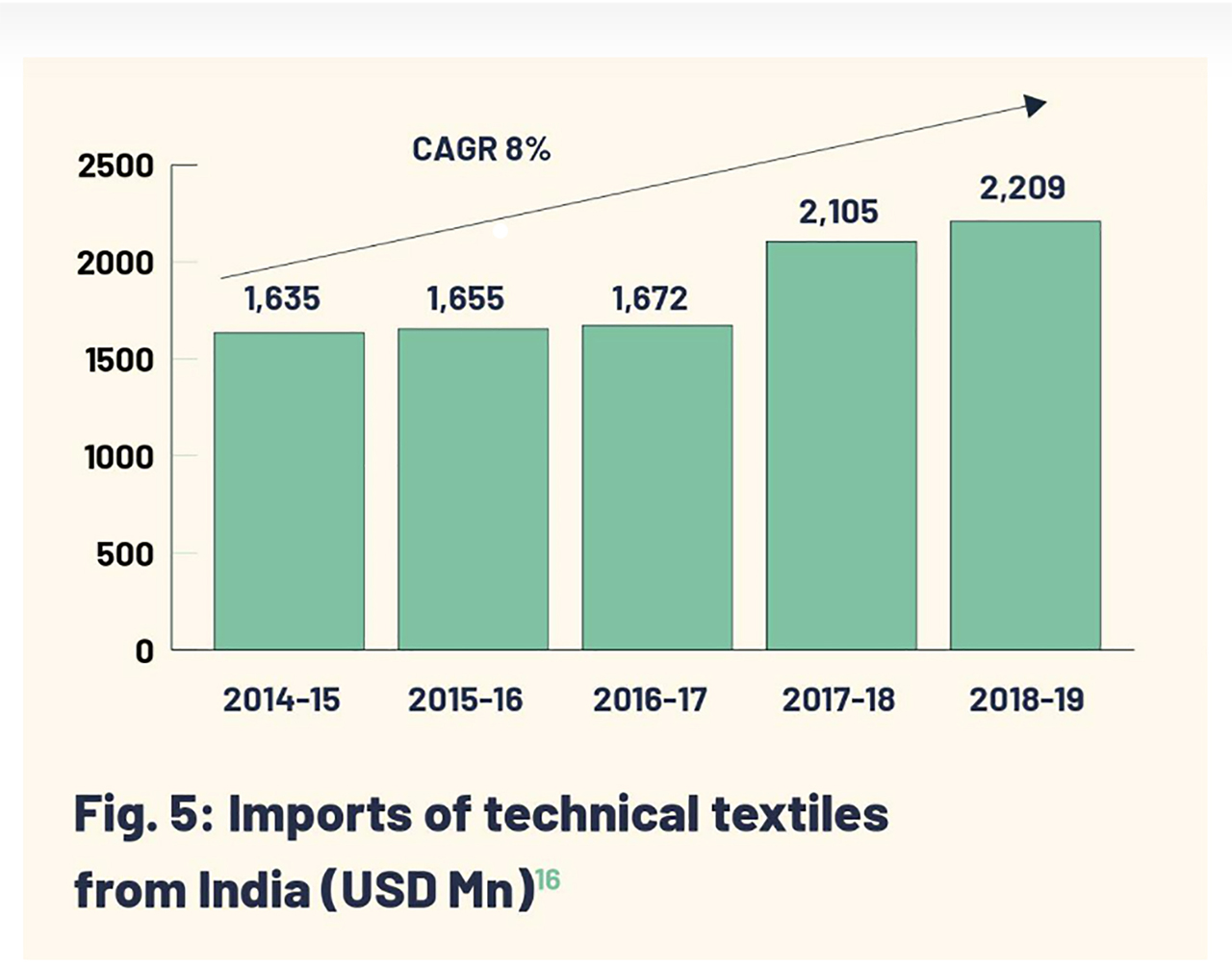Will the PLI scheme bring in structural change in making the Indian textile manufacturing competitive? Gurudas Aras, Strategic Business Consultant (India), APS GmbH, Germany, provides a few pointers

As is well-known, Indian exports are more cotton-centric while nearly 60% to 70% of the global textile trade happens in manmade fibre-based products, more so in apparels. As a result, the Indian share of global trade is restricted to only 5.5%. In fact, in spite of India being the second-largest producer of manmade fibres (MMF) in the world, the country’s share in MMF garments is a mere 2% while it is dominated by China (34%) followed by Vietnam and Bangladesh. Recently Vietnam has overtaken Bangladesh in RMG exports. India loses out to other countries due to lack of cost-competitiveness and absence of trade agreements with major trade blocks like the EU and US as against competing nations.
Also, another reason is the limited processing and finishing capability of the Indian industry for the MMF and high lycra content fabrics. The EU and the US are the largest RMG export destinations for India but it is slowly losing the game to Bangladesh and Vietnam due to duty preferential treatment to the latter. Bangladesh could improve its share in EU exports due to low cost of labour while Vietnam increased its share in US exports as it acquired the ‘most favoured nation’ (MFN) status in 2001. While India’s overall merchandise exports reached an all-time quarterly high of USD 95 billion in the three months ending June 2021, readymade garments experienced double-digit declines as compared to the June 2019 levels.
India currently ranks sixth in the top world exporters of textile and apparel and has witnessed a gradual decline in its share in global exports of textile and apparel. In view of the above situation, it is high time that Indian manufacturers and exporters take a serious note of the present shortcomings and the real reasons for failure to make inroads in the global markets. What is required utmost is to diversify the product portfolio systematically with the addition of MMF-based products, thereby increasing India’s presence in the global MMF garment trade. To boost domestic manufacturing and exports, the government had recently approved the Production Linked Incentive (PLI) scheme for the sector with a total outlay of Rs 10,680 crore under the aegis of attaining the status of self-reliance.

Scope of the PLI Scheme
The PLI scheme is presently restricted to manufacturing of MMF-based products and technical textiles. By focusing on these two high potential segments, the PLI scheme for textiles is expected to bring about structural changes in the textile sector. With the introduction of such a scheme, the foremost intention of the government is to boost the country’s export value by building large-scale production of downstream products, which has higher value-addition potential. The PLI scheme would enhance India’s manufacturing capabilities by increasing investment and production in the textile apparel sector, especially in the MMF segment and technical textiles.
Tapping the Right Opportunities
In a nutshell, the government sees big opportunity in the textile sector for increasing India’s global footprint and that is the reason why textile manufacturing has been identified amongst the 13 most potential segments for PLI scheme. The PLI scheme alone is not the panacea for all the issues faced by textile manufacturers. But certainly, if the scheme is augmented with other important initiatives by the industry, it can be very successful. The industry has to keep pace with the changes happening in the competitive global world by adapting to contemporary technologies, best manufacturing practices and choosing the right product mix. Today India loses out to competitors in cost-competitiveness.

For overcoming that, new MMF garment capacities of larger scales are required to be built in low-cost states like Bihar, Jharkhand, Assam and the northeast region. Manufacturing needs to adapt fast to automation and high-quality standards to stand out in the scenario of global competition. Investment in skill development initiative will be the key to overcome lower labour productivity which traditionally has been India’s weak spot. The PLI scheme needs to take cognisance of all these important factors alongside fiscal support to local manufacturing.
Once we are able to achieve all the above mentioned objectives under the PLI scheme, the way to bring in structural change in the manufacturing sector will be much easier. The target should be to gradually replace China as the manufacturing hub by creating a solid and sustainable alternative for the world to take notice of. The size of the opportunity will be so big that even if Vietnam, Bangladesh, Sri Lanka and Pakistan get their share of the global market, India still will have a sizeable portion of the pie to eat. The success story of Indian home textile industry can certainly be repeated for MMF garments and technical textiles with the help of the PLI scheme and many other government initiatives.

Also, ‘Brand India’ needs a structural boost in the minds of the global buyers and that can only happen over a period of time if Indian manufacturers consistently deliver quality at competitive price, adhere to commitments and follow strict compliance in manufacturing. Sustainability will also play a greater role in the years to come and it needs to be an integral part of the entire value chain in textiles in order to qualify for being a compliant manufacturing country. The geopolitical factors are also favouring India such as China facing the Xinjiang cotton issue, China+1 policy of buyers and the EU planning to withdraw preferential duty treatment to Pakistan.

Government support through initiatives such as the PLI scheme, Make in India, re-instatement of the RoSCTL scheme and removal of anti-dumping duty on viscose fibres augur well for the industry to confidently put forward its efforts. With the entry of Piyush Goyal as the new textile minister, the spirit of the industry has changed positively. In my opinion, this is the most opportune time for India to have a stronger and bigger footprint in the global textile world and the PLI scheme might be the gate-opener for that. The ‘Chak De’ moment for the Indian textile industry has arrived after a long wait. Meanwhile, only the coming period will give an answer to whether the PLI scheme will be a real game-changer for the Indian textile manufacturing sector.
—
The PLI scheme is expected to cover approximately 40 products categories under MMF and about 10 in the technical textile segment. The MMF category largely covers garments covered in Chapters 61 and 62 of the Customs Tariff Act like jerseys, pullovers, trousers, socks and shirts of manmade fibres. The technical textile category will cover products like diapers, adhesive dressings, bandages and safety airbags, as covered under some specific HSNs under Chapters 30, 39 or 59 of the Customs Tariff Act. Some of the important outcomes of the PLI scheme, specific to the textile segment will be:
• It will encourage creating state-of-the-art large capacities in MMF garments which India needs badly.
• It will help in making garments an export growth engine like China, Vietnam and Bangladesh.
• It will help in making the manufacturing more cost-competitive.
• It will encourage manufacturing of many import substitute products, thus saving precious foreign exchange.
• It will help in building value chains across the entire spectrum of garment manufacturing and build large-scale production.
• It will bring in a new era of integrated manufacturing as compared to the current structure of the industry in India.
• It will boost the exports of MMF products and technical textiles, thus increasing India’s share in the global trade.
• It will help in creating some global champions in MMF garments and technical textiles.
• It will offer an alternative destination to global buyers in supporting their China+1 policy initiative for sourcing.